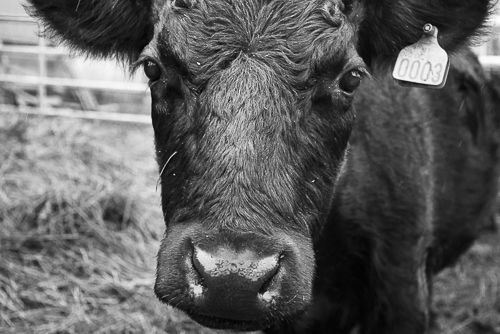Having joined Evas hage, a newly started company for helping small-scale producers of foods and drinks, by letting everyone buy products from the producers via Evas hage, meaning the garden of Eve. Besides, members who pay a yearly subscription are also invited to visit the producers who deliver their produce to Evas hage. Since we were invited to visit Ånerud farm where a very small race of cattle, called Dexter, is being raised, it was only natural to come along.
After having eaten delicious hamburgers made from meat from Dexter cattle which had been raised at the same farm, the owner Alf-Erik Finsrud gave us a short introduction to his farm. Originally his parents were running the farm and he was given sole responsibility for the farm in 1996, while now 20 years later he is also the sole owner because his siblings haven’t asked for any part of the farm during that time.
His parents were growing grain and raising dairy cows like most or all other farms in this area. However, when Alf-Erik took over the farm, he had different plans. Instead of growing grain and having to plow the fields yearly, he turned to growing grass instead, avoiding any plowing. Besides, he didn’t want to raise dairy cows any more. Instead, he was thinking about having Angus or Hereford cattle, but ended instead up with Dexter cattle, which was rather unusual 20 years ago. Finally, his farm should be totally organic, meaning that no pesticides or herbicides should be used.
Dexter cattle are small animals, they don’t make deep tracks in the ground, they are hardy and they stay outside all year, they don’t need concentrated feed, they don’t need much food and they are capable of keeping the cultural landscape open. The area below the farm consists of pastures from which Alf-Erik gets all the feed needed for his animals. After having received a short introduction to the farm, we were divided into two groups: one to see the earthworms and one to see the cattle.
I joined the last one first and after having been asked to approach the animals slowly and avoid abrupt movements, we went down to the enclosure where they were staying just for our visit. In general, they are allowed to roam freely on the pastures below the farm, making them more difficult to approach. Inside the enclosure there were 10-15 cattle, an ox named Rufus, some cows and some calves, both female and male. Being a conscientious farmer, Alf-Erik sees to his animals daily and all of them have names. During our visit, the cows were served bread, which they ate eagerly. Besides, all the cattle looked clean and healthy.
Contrary to the big udders of dairy cows, the udders of the Dexter cows were tiny indeed, but at least big enough that we could watch a calf suckle the udders of its mother.
All the cattle at this farm are grass-fed and, according to this article, they have a 1:1 ratio between omega-3 and omega-6 fats, which are beneficial for us as consumers of meat. Last but not least, Alf-Erik told us that he lets meat from his cattle hang in a cool room in order to improve and concentrate the flavour of the meat. Unfortunately, this method is hardly used by modern slaughterhouses any more because it’s expensive. Finally, there is an article about grass-fed beef and here is another one for those who want to know more.
Having let us visit the cattle and answer our questions, Alf-Erik showed us his earthworm farm, which was located in a barn on the farm. Being an avid angler for many years, he started raising earthworms for fishermen about 6 years ago. In the beginning, he didn’t know how to do it, but he somehow got in touch with an earthworm farmer in the Netherlands. After having paid a visit to the farm and being shown how to raise earthworms, he started his own earthworm farm. He buys earthworms from the farm in the Netherlands and he feeds them a secret recipe. Having entered the earthworm farm, we could see 3-4 plastic cases apparently full of soil, inside of which the earthworms were living. Light and heat are always kept on in order to let the earthworms live in a pleasant environment . The earthworms lay eggs, which are turned into mature earthworms ready for selling after about 8 months.
When the earthworms are ready to be sold, Alf-Erik brings the soil with the earthworms inside a potato sorting machine which he has converted such that it can separate the earthworms from the soil. Then, he puts them in plastic boxes with perforated lids. The earthworms can live for 6-8 weeks inside the boxes, which are for sale 24 hours a day. In fact, his earthworm shop is always open, and his customers just pay the required amount in a box. Salmon fishermen, in particular, buy his earthworms and he sells about 500 kg yearly. They are of course also for sale at Evas hage.

